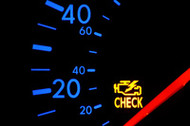Common Causes of Check Engine Light
Posted by J&B Tool Sales on 18th Jun 2015
Roughly 1 in 10 cars and trucks are running with the check engine light on. Many drivers turn a blind to this warning, assuming their vehicle is okay to drive as long as the ignition cranks. While most causes of the check engine light are minor and involve nothing more than a reset, others are more severe, indicating critical problems that can cause or contribute to an accident.
Broken, Loose or Faulty Gas Cap
Just because the warning light says “check engine” doesn't necessarily mean that there's something wrong with your engine. On the contrary, one of the most common causes of the check engine light is a broken, loose or faulty gas cap. When gasoline fumes (hydrocarbons) are allowed to evaporate from the tank – due to a faulty gas cap – it will trigger this warning. This is a safeguard in modern-day vehicles that's designed to reduce emissions of Eco-unfriendly pollutants.
Malfunctioning Catalytic Converter
The catalytic converter is designed to convert your vehicle's otherwise harmful carbon monoxide emissions into carbon dioxide. When it's unable to perform this conversion, though, carbon monoxide will escape; thus, triggering the check engine light. Signs of a malfunctioning catalytic converter may include poor gas mileage, engine running at hotter than usual, and failing the emissions test.
Related Reading: What is a Catalytic Converter?
Worn Out Spark Plugs
A third possible reason your vehicle's check engine light is on involves worn out spark plugs. As the name suggests, spark plugs handle sparking the fuel to create ignition and combustion. They are connected to the ignition coil that receives electrical voltage. Normally, they perform this job flawlessly. If your spark plugs are old and worn out, though, they may have a difficult time igniting the fuel, which could trigger the check engine light.
Related Reading: 5 Signs Your Spark Plugs are Going Bad
Oxygen Sensor Needs Replacing
The oxygen sensor works silently to measure the amount of oxygen in a vehicle's exhaust. When it goes bad, the vehicle will end up burning significantly more fuel – sometimes as much as 30-40% more. Thankfully, most cars are trucks are designed with oxygen sensors to alert the driver of this problem, flashing the check engine light when it occurs.
How To I Solve My Check Engine Light?
You have one of two different options when it comes to fixing your vehicle's check engine light. You can take your vehicle to a dealer or automotive repair shop, or you can do it yourself. If you're looking to save money, it's recommended that you do it yourself.
Using a diagnostics tool , find the error code attributed to your vehicle's check engine light. Next, cross reference that code with a list of check engine error codes either online or in your owner's manual. Finally, search online for others with the same issue and what they did to fix the problem.
Related Reading: What's the Difference Between the Check Engine Light and Maintenance Required

